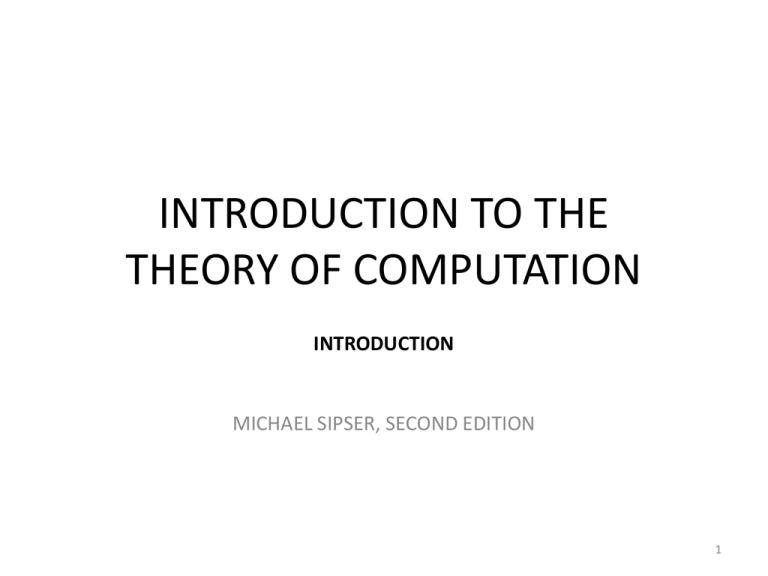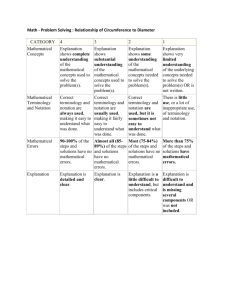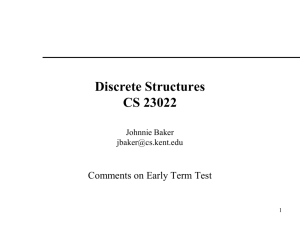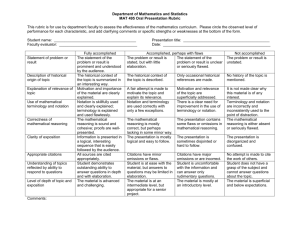MATHEMATICAL NOTIONS AND TERMINOLOGY
advertisement

INTRODUCTION TO THE
THEORY OF COMPUTATION
INTRODUCTION
MICHAEL SIPSER, SECOND EDITION
1
Note for the students:
• These slides are meant for the lecturers to
conduct lectures only. It is NOT suitable to be
used as a study material.
• Students are expected to study by reading the
textbook for this course:
2
AUTOMATA, COMPUTABILITY, AND
COMPLEXITY
What are the fundamental capabilities and
limitations of computers?
3
AUTOMATA, COMPUTABILITY, AND
COMPLEXITY
• 1930s the meaning of computation.
• COMPLEXITY THEORY
• Computer problems come in different
varieties; some are easy, and some are hard.
• For example:
– Easy : the sorting problem is an easy one.
– Hard: Encoding and Decoding
4
COMPLEXITY THEORY
• Computer problems come in different
varieties; some are easy, and some are hard.
• For example, the sorting problem is an easy
one.
• For example, scheduling problem is a hard one
or (cryptography - because secret codes
should be hard to break without the secret
key or password.).
5
COMPLEXITY THEORY
What makes some problems computationally hard and
others easy?
• First, by understanding which aspect of the problem is
at the root of the difficulty.
• Second, you may be able to settle for less than a perfect
solution to the problem.
• Third, some problems are hard only in the worst case
situation, but easy most of the time.
• Finally, you may consider alternative types of
computation such as randomized computation, that can
speed up certain tasks.
6
COMPUTABILITY THEORY
“problem of determining whether a mathematical
statement is true or false”
• The theories of computability and complexity are
closely related.
• In complexity theory, the objective is to classify
problems as easy ones and hard ones.
• In computability theory the classification of
problems is by those that are solvable and those
that are not.
7
AUTOMATA THEORY
• Automata theory deals with the definitions
and properties of mathematical models of
computation.
• Mathematical models:
• the finite automaton model, is used in text
processing, compilers, and hardware design.
• the context-free grammar model, is used in
programming languages and artificial intelligence.
8
MATHEMATICAL NOTIONS AND
TERMINOLOGY
• SETS: A set is a group of objects represented
as a unit. (any type of object, including numbers, symbols, and even other sets)
• The objects in a set are called its elements or
members. {7, 21, 57} – the set contains the elements 7, 21, and 57.
-
The symbols
denote set membership and nonmembership.
-
A is a subset of B, written
if every member of A also is a member of B.
A is a proper subset of B, written
, if A is a subset of B and not equal to B.
Ex.: The set {1, 2} is a proper subset of {1, 2, 3}.
9
MATHEMATICAL NOTIONS AND
TERMINOLOGY
- multiset - ?
- infinite set - ?
- The set of natural numbers N is written {1,2,3,...}.
- The set of integers Z is written {... ,-2,-1,0,1,2,…}.
- The set with 0 members is called the empty set and
is written Ø.
10
MATHEMATICAL NOTIONS AND
TERMINOLOGY
11
MATHEMATICAL NOTIONS AND
TERMINOLOGY
12
MATHEMATICAL NOTIONS AND
TERMINOLOGY
SEQUENCES AND TUPLES
A sequence of objects is a list of these objects in
some order.
– For example, the sequence 7, 21, 57 would be
written (7, 21, 57).
• In a set the order doesn't matter, but in a
sequence it does. Hence (7,21, 57) is not the
same as (57, 7, 21).
13
MATHEMATICAL NOTIONS AND
TERMINOLOGY
• Sequences may be finite or infinite. Finite
sequences often are called tuples. A sequence
with k elements is a k-tuple.
– For example, (7,21, 57) is a 3 -tuple. A 2-tuple is
also called a pair.
14
MATHEMATICAL NOTIONS AND
TERMINOLOGY
• Sets and sequences may appear as elements
of other sets and sequences.
– For example, the power set of A is the set of all
subsets of A. If A is the set {0, 1}, the power set of
A is the set {Ø, {0}, {1}, {0, 1} }.
• The set of all pairs whose elements are 0s and
1s is { (0, 0), (0,1), (1, 0), (1,1) }.
15
MATHEMATICAL NOTIONS AND
TERMINOLOGY
• If A and B are two sets, the Cartesian product
or cross product of A and B, written A x B, is
the set of all pairs wherein the first element is
a member of A and the second element is a
member of B.
EXAMPLE:
If A = {1, 2} and B {x, y, z},
A x B { (1, x), (1, y), (1, z), (2, x), (2, y), (2, z) }.
16
MATHEMATICAL NOTIONS AND
TERMINOLOGY
FUNCTIONS AND RELATIONS
• A function is an object that sets up an inputoutput relationship.
• A function takes an input and produces an
output.
f(a) = b
– If f is a function whose output value is b when the
input value is a.
17
MATHEMATICAL NOTIONS AND
TERMINOLOGY
• A function also is called a mapping, and, if f
(a) = b, we say that f maps a to b.
– For example, the absolute value function abs takes
a number x as input and returns x:
– if x is positive or negative.
abs(2) = abs(-2) = 2.
18
MATHEMATICAL NOTIONS AND
TERMINOLOGY
• The set of possible inputs to the function is
called its domain.
• The outputs of a function come from a set
called its range.
• The notation for saying that f is a function
with domain D and range R is f: DR
• function abs: Z Z.
19
MATHEMATICAL NOTIONS AND
TERMINOLOGY
Example:
– This function adds 1 to its input and then outputs
the result modulo 5. A number modulo m is the
remainder after division by m. Consider the
functions: {0,1, 2, 3, 4} {O, 1, 2, 3, 4}.
n
0
1
2
f (n)
1
2
3
3
4
4
0
20
MATHEMATICAL NOTIONS AND
TERMINOLOGY
Example: The function g is the addition function
modulo 4.
• for some sets A1, ... Ak, the input to f is a k-tuple
(a1, a2 , ... , ak) and we call the ai the arguments
to f. A function with k arguments is called a k-ary
function, and k is called the arity of the function.
If k is 1, f has a single argument and f is called a
unary function. If k is 2, f is a binary function.
21
MATHEMATICAL NOTIONS AND
TERMINOLOGY
• infix notation - usually is written in infix notation
with the + symbol between its two arguments. a
+b
• prefix notation
add(a, b). Or + a b
• postfix notation
ab+
• An example of such a function notation would be
S(1,3) in which the function S denotes addition:
S(1,3) = 1+3 = 4.
• A predicate or property is a function whose range
is {TRUE, FALSE}.
22
MATHEMATICAL NOTIONS AND
TERMINOLOGY
A property whose domain is a set of k-tuples
…. x A is called a relation.
Ax
S = {a є DI P(a) = TRUE} ??? equivalence relation???
23
MATHEMATICAL NOTIONS AND
TERMINOLOGY
•
•
•
•
GRAPHS
An undirected graph, or simply a
graph, is a set of points with
lines connecting some of the
points. The points are called
nodes or vertices, and the lines
are called edges.
The number of edges at a
particular node is the degree of
that node.
Graphs frequently are used to
represent data. (labeled graph)
Subgraph – subset of the set(s)
formal description ({1, 2, 3, 4, 5},
{(1, 2), (2, 3), (3, 4), (4, 5), (5, 1)})
formal description ???
24
MATHEMATICAL NOTIONS AND
TERMINOLOGY
• A path in a graph is a sequence of nodes
connected by edges. A simple path is a path that
doesn't repeat any nodes.
• A graph is connected if every two nodes have a
path between them.
• A path is a cycle if it starts and ends in the same
node.
• A simple cycle is one that contains at least three
nodes and repeats only the first and last nodes.
• A graph is a tree if it is connected and has no
simple cycles. A tree may contain a specially
designated node called the root.
• The nodes of degree =>1 in a tree, other than the
root, are called the leaves of the tree.
25
MATHEMATICAL NOTIONS AND
TERMINOLOGY
• directed graph - If it has
arrows instead of lines.
• The number of arrows
pointing from a particular
node is the outdegree of
that node, and the
number
of
arrows
pointing to a particular
node is the indegree.
The formal description of the graph is
({1,2,3,4,5,6}, {(1,2), (1,5), (2,1), (2,4),
(5,4), (5,6), (6,1), (6,3)}).
26
MATHEMATICAL NOTIONS AND
TERMINOLOGY
STRINGS AND LANGUAGES
“A language is a set of strings”
- An alphabet is any nonempty finite set.
- The members of the alphabet are the symbols of the
alphabet.
- We generally use capital Greek letters ∑ and Γ to designate
alphabets and a typewriter font for symbols from an
alphabet.
- Examples of alphabets:
• ∑1 = {0,1}; ∑2 ={a,b,c,d,e,f,g.hij,k,lm,n,o,p,q,r,s,t,u,v,w,x,y,z};
• Γ = {0,1,x,y,z}.
27
MATHEMATICAL NOTIONS AND
TERMINOLOGY
• A string over an alphabet is a finite sequence of
symbols from that alphabet, usually written next to
one another and not separated by commas.
• If ∑1 = {0,1}, then 01001 is a string over ∑1.
• If ω is a string over ∑, the length of ω , written Iωl, is
the number of symbols that it contains.
• The string of length zero is called the empty string and
is written є
• The reverse of ω , written ωR, is the string obtained by
writing ω in the opposite order.
• Thus the lexicographic ordering of all strings over the
alphabet {0,1} is (є, O, 1, 00, 01, 10, 11,000,. .. ).
28
MATHEMATICAL NOTIONS AND
TERMINOLOGY
BOOLEAN LOGIC
• Boolean
logic
is
a
mathematical system built
around the two values TRUE
and FALSE.
• The values TRUE and FALSE
are called the Boolean values
and are often represented by
the values 1 and 0.
• Boolean operations: negation
or NOT (¬), conjunction, or
AND (Λ), disjunction or OR (v)
29
MATHEMATICAL NOTIONS AND
TERMINOLOGY
• Example, if P is the Boolean value representing
the truth of the statement "the sun is shining"
and Q represents the truth of the statement
"today is Monday", we may write P Λ Q to
represent the truth value of the statement "the
sun is shining and today is Monday“
• The exclusive or, or XOR, operation is designated
by the Φ symbol and is 1 if either but not both of
its two operands are 1.
• The equality operation, written with the symbol
↔, is 1 if both of its operands have the same
value.
• Finally, the implication operation is designated
by the symbol → and is 0 if its first operand is 1
and its second operand is 0; otherwise → is 1.
30
MATHEMATICAL NOTIONS AND
TERMINOLOGY
31








